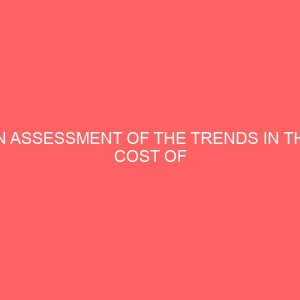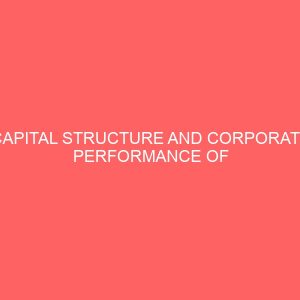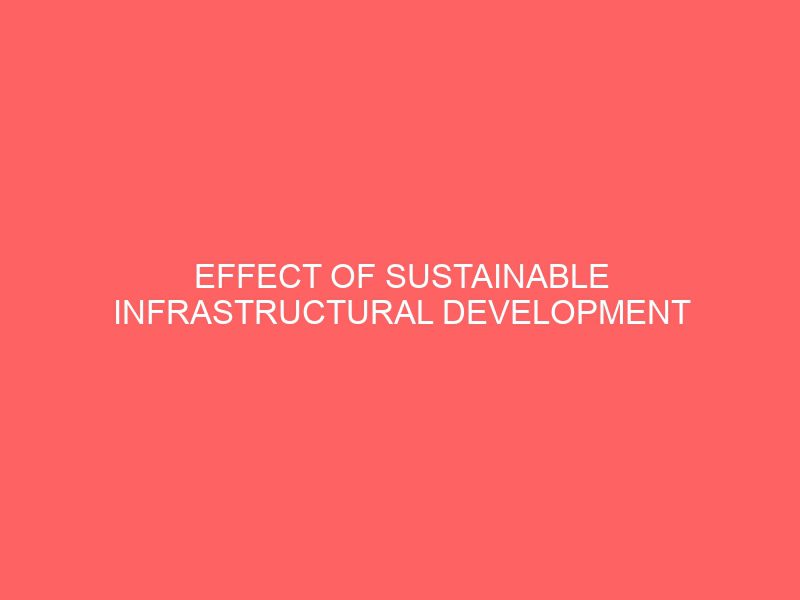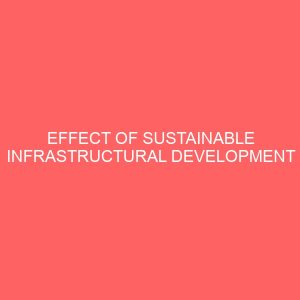Description
THIS PROJECT IS ON EFFECT OF SUSTAINABLE INFRASTRUCTURAL DEVELOPMENT ON ECONOMIC DEVELOPMENT OF NIGERIA.
ABSTRACT
In this research work on the effect of sustainable infrastructural development on economic development of Nigeria. The researcher examined the effect of sustainable infrastructure on the gross domestic product (GDP)of Nigeria. The impact of infrastructural development on the Gross Fixed Capital Formation (GFCF) of Nigeria. Explore the impact that infrastructural development has on Nigeria’s economic growth. Data for the study was sourced through CBN Annual report and journal articles related to the subjects matter. The data collected was analyzed using SPSS. The results of the study shows that The results as presented in the coeficiente revealed that calculated t-statistics (t = -2.723) for parameter GDP is greater than tabulated t-statistics at 0.05 level of significance. The regression equation also revealed that GDP accounted for -0.881 unit for every increase in infrastructure expenses. The coefficient of determinant (R2) 0.921 indicating that 92% of variation in GDP increase is caused by variation infrastructure expenses. The relationship between GDP and infrastructure expenses is high, positive and statistically significant at 0.05 level (r=0.960, p<0.05). The overall regression model is statistically significant in terms of its overall goodness of fit (f = 12.22, p < 0.05). As a result of this the study accepts the alternative hypothesis meaning that Sustainable infrastructure affects the gross domestic product (GDP) of Nigeria. It was also observed that infrastructural development has great impact on the Gross Fixed Capital Formation (GFCF) of Nigeria. Based on the findings the researcher recommends that to attain significant accelerated development over the next 10 -15 years, Nigeria will have to expand its infrastructure development funding in tangible capacities by 24% of GDP over 10 years or 18% of GDP over 15 years to catch-up with most Asian countries. This of course is based on the assumptions that Asian countries will maintain a modest growth rate of 6%/annum with spending on infrastructure remaining in the average 6% range.
CHAPTER ONE
INTRODUCTION
1.1 Background of the study
The attainment of sustainable economic growth remains a paramount objective of every country. A primary source required for achieving this objective is through increased domestic productivity. However, for this to occur, such country must be able to create sufficient domestic physical capital to stimulate such desired economic growth. In other words, fixed capital formation is a major contributor, catalyst and determinant of a country’s economic growth.
Gross Fixed Capital Formation (GFCF) according to the World Bank (2014) refers to fixed assets accumulation such as land improvements, equipment, machinery construction of roads and railways, building of schools etcetera, required for augmenting a country’s economic productivity. This definition reiterates and captures the predictions of Romer (2008) and Lucas (2007) Growth Models which stipulates that increased growth rates can be achieved by increasing capital accumulation. Also, the building of schools leads to improved educational enrolment rate which will enhance the quality of human capital. The improvement of human capital in this regards will ensure innovation, invention and enhancement of productivity in the economy. Likewise, the investment in machinery and equipment will also increase the efficiency of labour productivity. Furthermore, Bakare (2011) explained capital formation as the “proportion of present income saved and invested in order to augment future output and income”. This definition buttresses the importance of savings as an integral element needed for creating (GFCF) and enhancing economic growth. Therefore, it can be concluded that a country with low domestic marginal propensity to save is likely to have poor capital formation which potentially impedes economic growth and vice versa. This is because, such country will have an insufficient pool of loanable funds for domestic investment into physical capital. More importantly, the availability of quality physical capital attracts Foreign Direct Investment (FDI) inflow, which is an integral macro-economic variable necessary for increasing a country’s economic prosperity. In a broader perspective, capital formation in the financial economics lingual refers to savings drives, developing of capital and secondary markets and privatizing financial institutions (Ray, 2013). Ray, (2013) opined that GFCF results in increased production in the long run which eventually causes share prices to rise, thus increasing profitability which in the end has a positive spillover effect on a country’s economic growth. Based on the discussion so far, an intuitive conclusion that a key precondition for ensuring and enhancing sustainable economic growth is through increased fixed capital formation. This study is geared towards investigating the effect of sustainable infrastructural development on economic growth in Nigeria.
1.2 Statement of the Problem
In recent years, Nigeria has experienced increased infrastructural transformation in terms of building of more schools, road, telecommunication facilities and etcetera. However, there are only a few studies found to have investigated the impact that these infrastructural development has on Nigeria’s economic growth. Thus, the aim of this study is geared towards contributing to the existing studies by investigating the contribution and impact that infrastructural development has on Nigeria’s economic growth.
1.3 Objectives of the study
The aim of this research work is to examine the effect of sustainable infrastructural development on economic development of Nigeria. The specific objectives of this research work include the following:
1. To examine the effect of sustainable infrastructure on the gross domestic product (GDP) of Nigeria.
2. To evaluate the impact of infrastructural development on the Gross Fixed Capital Formation (GFCF) of Nigeria.
3. To explore the impact that infrastructural development has on Nigeria’s economic growth.
4. To investigate whether there is causal relationship existing between infrastructural development and economic growth in Nigeria.








Reviews
There are no reviews yet.